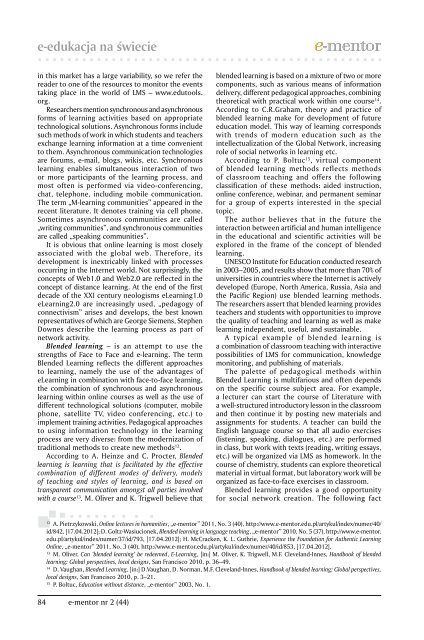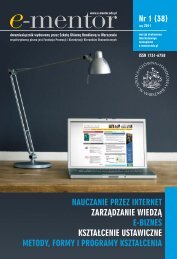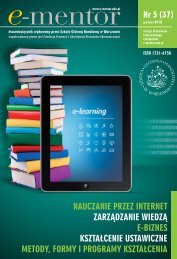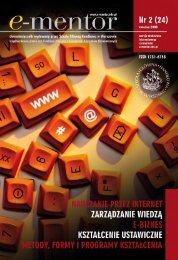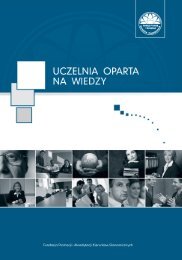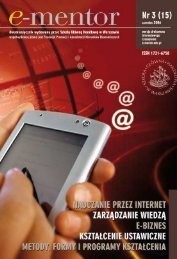e-edukacja na świeciein this market has a large variability, so we refer thereader to one of the resources to monitor the eventstaking place in the world of LMS – www.edutools.org.Researchers mention synchronous and asynchronousforms of learning activities based on appropriatetechnological solutions. Asynchronous forms includesuch methods of work in which students and teachersexchange learning information at a time convenientto them. Asynchronous communication technologiesare forums, e-mail, blogs, wikis, etc. Synchronouslearning enables simultaneous interaction of twoor more participants of the learning process, andmost often is performed via video-conferencing,chat, telephone, including mobile communication.The term „M-learning communities” appeared in therecent literature. It denotes training via cell phone.Sometimes asynchronous communities are called„writing communities”, and synchronous communitiesare called „speaking communities”.It is obvious that online learning is most closelyassociated with the global web. Therefore, itsdevelopment is inextricably linked with processesoccurring in the Internet world. Not surprisingly, theconcepts of Web1.0 and Web2.0 are reflected in theconcept of distance learning. At the end of the firstdecade of the XXI century neologisms eLearning1.0eLearning2.0 are increasingly used, „pedagogy ofconnectivism” arises and develops, the best knownrepresentatives of which are George Siemens, StephenDownes describe the learning process as part ofnetwork activity.Blended learning – is an attempt to use thestrengths of Face to Face and e-learning. The termBlended Learning reflects the different approachesto learning, namely the use of the advantages ofeLearning in combination with face-to-face learning,the combination of synchronous and asynchronouslearning within online courses as well as the use ofdifferent technological solutions (computer, mobilephone, satellite TV, video conferencing, etc.) toimplement training activities. Pedagogical approachesto using information technology in the learningprocess are very diverse: from the modernization oftraditional methods to create new methods 12 .According to A. Heinze and C. Procter, Blendedlearning is learning that is facilitated by the effectivecombination of different modes of delivery, modelsof teaching and styles of learning, and is based ontransparent communication amongst all parties involvedwith a course 13 . M. Oliver and K. Trigwell believe thatblended learning is based on a mixture of two or morecomponents, such as various means of informationdelivery, different pedagogical approaches, combiningtheoretical with practical work within one course 14 .According to C.R.Graham, theory and practice ofblended learning make for development of futureeducation model. This way of learning correspondswith trends of modern education such as theintellectualization of the Global Network, increasingrole of social networks in learning etc.According to P. Boltuc 15 , virtual componentof blended learning methods reflects methodsof classroom teaching and offers the followingclassification of these methods: aided instruction,online conference, webinar, and permanent seminarfor a group of experts interested in the specialtopic.The author believes that in the future theinteraction between artificial and human intelligencein the educational and scientific activities will beexplored in the frame of the concept of blendedlearning.UNESCO Institute for Education conducted researchin 2003–2005, and results show that more than 70% ofuniversities in countries where the Internet is activelydeveloped (Europe, North America, Russia, Asia andthe Pacific Region) use blended learning methods.The researchers assert that blended learning providesteachers and students with opportunities to improvethe quality of teaching and learning as well as makelearning independent, useful, and sustainable.A typical example of blended learning isa combination of classroom teaching with interactivepossibilities of LMS for communication, knowledgemonitoring, and publishing of materials.The palette of pedagogical methods withinBlended Learning is multifarious and often dependson the specific course subject area. For example,a lecturer can start the course of Literature witha well-structured introductory lesson in the classroomand then continue it by posting new materials andassignments for students. A teacher can build theEnglish language course so that all audio exercises(listening, speaking, dialogues, etc.) are performedin class, but work with texts (reading, writing essays,etc.) will be organized via LMS as homework. In thecourse of chemistry, students can explore theoreticalmaterial in virtual format, but laboratory work will beorganized as face-to-face exercises in classroom.Blended learning provides a good opportunityfor social network creation. The following fact12A. Pietrzykowski, Online lectures in humanities, „e-<strong>mentor</strong>” 2011, No. 3 (40), http://www.e-<strong>mentor</strong>.edu.pl/artykul/index/numer/40/id/842, [17.04.2012]; D. Goltz-Wasiucionek, Blended learning in language teaching, „e-<strong>mentor</strong>” 2010, No. 5 (37), http://www.e-<strong>mentor</strong>.edu.pl/artykul/index/numer/37/id/793, [17.04.2012]; H. McCracken, K. L. Guthrie, Experience the Foundation for Authentic LearningOnline, „e-<strong>mentor</strong>” 2011, No. 3 (40), http://www.e-<strong>mentor</strong>.edu.pl/artykul/index/numer/40/id/853, [17.04.2012].13M. Oliver, Can ‘blended learning’ be redeemed, E-Learning, [in:] M. Oliver, K. Trigwell, M.F. Cleveland-Innes, Handbook of blendedlearning: Global perspectives, local designs, San Francisco 2010, p. 36–49.14D. Vaughan, Blended Learning, [in:] D.Vaughan, D. Norman, M.F. Cleveland-Innes, Handbook of blended learning: Global perspectives,local designs, San Francisco 2010, p. 3–21.15P. Boltuc, Education without distance, „e-<strong>mentor</strong>” 2003, No. 1.84 e-<strong>mentor</strong> nr 2 (44)
Distance Learning: Classification of Approaches and Termsindicates social significance of blended learning. TheSocrates Program supports development of nine lesswidely spoken European languages. These includeRomanian, Turkish, Lithuanian, Bulgarian, Slovenian,Dutch, Hungarian, Estonian, Maltese. Pedagogicaland technical solutions of the program are based onblended learning concept (http://www.nvolve.net).The purpose of these courses is to maintain andincrease use of these languages. Teams include severalpartner institutions in each country developingthese courses. Public and private universities,private language schools and consultants joined thedevelopment teams. Thus blended learning can beviewed as a real model of network communities.Therefore, its study is interesting from the point ofview of connectivism.The communities can interact at any time and anyplace, invite and involve experts in the subject area,finding a serious social support and constructivelearning experience, and gradually transform intoa community of experts, what is the most significantresult of education.Technological Approaches: TechnologyEnhanced Training (TET)Development of social networks has given rise tothe concept of TEL, the essence of which lies in the factthat each person can ignore educational institutionservices, and train himself directly on the web usingthe diversity of its resources. The concept describespossibilities of inclusion of social and technologicalinnovation in the learning practice, both for individualusers and organizations, regardless of the time,place and pace of learning. Field of TET is to supporteducational activities via appropriate technologicalmeans, without using the services of educationalinstitutions 16 .According modern pedagogical concepts 17 , learningcan be in accordance with different pedagogicalapproaches and didactic concepts. TET focuses on thecorrespondence between pedagogical approaches andtechnological solutions. The latter are very diverse, justto name a few: providing access to learning resourcesof depositories, educational hypermedia systems (e.g.MIT Open Course Ware), participation in educationalsocial networks (e.g. Global Development LearningNetwork – www.gdln.org) work using software(including LMS, CMS) of outstanding universitiesor open learning communities (e.g. MOODLE), etc.The main thing is to give a user the opportunity toorganize the complete learning process by technicalmeans.In our view TET can be represented as a pedagogicalsystem that includes educational resources (learningcontent), learning tools, learning methods. Educationalresources include a set of information formeddirectly by the user. Learning tools are technologicalsolutions aimed at the creation of resources and theirdelivery. Methods of learning activities are based oncommunication with resources, communication withexperts, interaction with the software.Some of the TET models are the following: Websupportedcollaborative learning (WSCL). Computer-Based Training (CBT) and Web-Based training (WBT). Inour opinion WSCL reflects learning in social networks,but WBT and CBT concepts describe an attempt ofeducational institutions to maintain their niche in theworld of social networks.Web-supported collaborative training (WSCT) isa model that allows people to work together viamodern technology and social network, and thatcorresponds to the concept of eLearning2.0. Tools forimplementation of such learning are often referred toas Smart Boards. WSCL is taking its first steps, so we canonly offer a few hypothetical considerations about itsorganization, the advantages and disadvantages. Thetechnologies enable users to work with large amountsof information both together and individually. Theoutcome of learning often represents the quintessenceof knowledge and experience of networks’ members.It is convenient for professionals, but requires newapproaches for assessing students. In connectionwith this pedagogical goal a training field basedon separate private and common learning areasfor students should be created. We are currentlydeveloping a program of studies of these techniqueson the example of an international learning networkVirtual World of Russian Museum.Computer-Based Training (CBT) / Web-Based training(WBT) As an example, the Virtual campus of thePennsylvania State University (USA) has developedtraining programs that can be provided to the user onrequest at a relatively cheap price. User gets access toinformation via a CD-ROM (CBT), or via the learningnetwork (WBT). Evaluation of training is usually heldin the form of tests, the results are evaluated usinga computer, and the user receives the results by16P. Wojciechowski, New Media in Education 2011 – a report from the conference, „e-<strong>mentor</strong>” 2011, No. 4 (41), http://www.e-<strong>mentor</strong>.edu.pl/artykul/index/numer/41/id/872, [17.04.2012]; J. Tashiro, K. Jóhannsdóttir, M.V. Martin, G.B. Reynaga, J. Thor, The Users’ Manualto the Unconscious Mind, „e-<strong>mentor</strong>” 2011, No. 1 (38), http://www.e-<strong>mentor</strong>.edu.pl/artykul/index/numer/39/id/834, [17.04.2012];P. Topol, Coming of Age in Second Life – book review, „e-<strong>mentor</strong>” 2011, No. 2 (39), http://www.e-<strong>mentor</strong>.edu.pl/artykul/index/numer/39/id/827, [17.04.2012]; P. Boltuc, An Introduction to Distance Learning in a New Era – a review, „e-<strong>mentor</strong>” 2010, No. 4 (36), http://www.e-<strong>mentor</strong>.edu.pl/artykul/index/numer/36/id/779, [17.04.2012].17H. McCracken, K.L. Guthrie, Experience the Foundation for Authentic Learning Online, „e-<strong>mentor</strong>” 2011, No. 3 (40), http://www.e-<strong>mentor</strong>.edu.pl/artykul/index/numer/40/id/853, [17.04.2012]; P. Wojciechowski, New Media in Education 2011 – a report from theconference, „e-<strong>mentor</strong>” 2011, No. 4 (41), http://www.e-<strong>mentor</strong>.edu.pl/artykul/index/numer/41/id/872, [17.04.2012]; P. Boltuc, AnIntroduction to Distance Learning in a New Era – a review, „e-<strong>mentor</strong>” 2010, No. 4 (36), http://www.e-<strong>mentor</strong>.edu.pl/artykul/index/numer/36/id/779, [17.04.2012].kwiecień 2012 85
- Page 2 and 3:
SPIS TREŚCI
- Page 4 and 5:
metody, formy i programy kształcen
- Page 6 and 7:
metody, formy i programy kształcen
- Page 8 and 9:
metody, formy i programy kształcen
- Page 10 and 11:
metody, formy i programy kształcen
- Page 12 and 13:
metody, formy i programy kształcen
- Page 14 and 15:
metody, formy i programy kształcen
- Page 16 and 17:
metody, formy i programy kształcen
- Page 18 and 19:
metody, formy i programy kształcen
- Page 20 and 21:
metody, formy i programy kształcen
- Page 22 and 23:
metody, formy i programy kształcen
- Page 24 and 25:
metody, formy i programy kształcen
- Page 26 and 27:
metody, formy i programy kształcen
- Page 28 and 29:
metody, formy i programy kształcen
- Page 30 and 31:
e-edukacja w krajuRzeczywistość r
- Page 32 and 33:
e-edukacja w krajuRysunek 1. Przewo
- Page 34 and 35: e-edukacja w krajuRysunek 6. Podrę
- Page 36 and 37: e-edukacja w krajunauczania w szko
- Page 38 and 39: e-edukacja w krajuRysunek 1. Tworze
- Page 40 and 41: e-edukacja w krajuRysunek 5. Widok
- Page 42 and 43: e-edukacja w krajucdŹródło: wido
- Page 44 and 45: e-edukacja w krajuAntropologiczne s
- Page 46 and 47: zarządzanie wiedząwspółpracowni
- Page 48 and 49: zarządzanie wiedząPodsumowanieWyd
- Page 50 and 51: zarządzanie wiedząW metodzie tej
- Page 52 and 53: zarządzanie wiedzą5. Przypisanie
- Page 54 and 55: kształcenie ustawiczneKształcenie
- Page 56 and 57: kształcenie ustawiczne• celem st
- Page 58 and 59: kształcenie ustawiczneuznać, że
- Page 60 and 61: kształcenie ustawicznerynku pracy.
- Page 62 and 63: e-biznesdyspozycji narzędzia oceni
- Page 64 and 65: e-biznesSpołeczności kupujących
- Page 66 and 67: e-biznesTabela 1. Cechy komunikacji
- Page 68 and 69: e-bizneswięcej czasu poświęcać
- Page 70 and 71: e-biznesSerwisy internetowe banków
- Page 72 and 73: e-biznesRysunek 1. Elementy, na kt
- Page 74 and 75: e-biznesważ obsługują one klient
- Page 76 and 77: e-biznesWykres 5. Szybkość ładow
- Page 78 and 79: e-biznesWykres 9. Szybkość ładow
- Page 80 and 81: e-biznesWykres 13. Średnia z sumy
- Page 82 and 83: e-edukacja na świecieDistance Lear
- Page 86 and 87: e-edukacja na świecieE-mail (CBT)
- Page 88: e-edukacja na świecie88 e-mentor n


